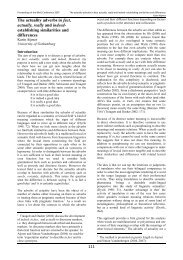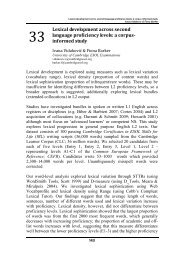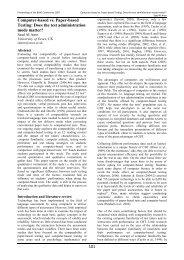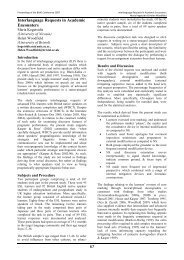Proceedings of the - British Association for Applied Linguistics
Proceedings of the - British Association for Applied Linguistics
Proceedings of the - British Association for Applied Linguistics
Create successful ePaper yourself
Turn your PDF publications into a flip-book with our unique Google optimized e-Paper software.
The Impact <strong>of</strong> <strong>Applied</strong> <strong>Linguistics</strong>: <strong>Proceedings</strong> <strong>of</strong> <strong>the</strong> 44th Annual Meeting <strong>of</strong> BAAL<br />
University <strong>of</strong> <strong>the</strong> West <strong>of</strong> England<br />
However, research on bi-literacy instruction has indicated <strong>the</strong> possibility<br />
that phonological awareness in <strong>the</strong> L2 is likely to develop as a result <strong>of</strong><br />
how L1 is taught, even when learners had to process an L2 with<br />
distinctively different writing scripts (Gottardo, Yan, Siegel, & Wade-<br />
Woolley, 2001; Wang, Koda, & Perfetti, 2003). In o<strong>the</strong>r words, L1 literacy<br />
background, ra<strong>the</strong>r than writing systems, might be <strong>the</strong> key to development<br />
<strong>of</strong> phonological processing skills.<br />
The present study aimed to investigate, on <strong>the</strong> one hand, whe<strong>the</strong>r Chinesespeaking<br />
children could develop phonological processing skills at subsyllabic<br />
level in English in <strong>the</strong> beginning <strong>of</strong> learning <strong>the</strong> new alphabetic<br />
language. On <strong>the</strong> o<strong>the</strong>r hand, it also attempted to explore whe<strong>the</strong>r <strong>the</strong>se<br />
skills might have, due to <strong>the</strong> method used to teach Chinese in Taiwan,<br />
transferred from Chinese to English.<br />
Method<br />
Participants, Materials, and Procedure<br />
A total <strong>of</strong> 63 fourth-graders from 2 classes were recruited from a suburban<br />
elementary school in sou<strong>the</strong>rn Taiwan. They were 31 boys and 32 girls. All<br />
participants were aged from 9 years to 9 years 11 months at <strong>the</strong> beginning<br />
<strong>of</strong> <strong>the</strong> experiment (M = 113.33, SD = 3.72 in months).<br />
The participants had a wide variance in <strong>for</strong>eign language learning<br />
experience. About 51% <strong>of</strong> <strong>the</strong>m started learning English from Grade 3 and<br />
received extracurricular English instruction from one to four hours a week.<br />
Fewer than a quarter had attended extra English lessons in Grade 1 and<br />
Grade 2. The mean <strong>of</strong> <strong>the</strong>ir English instruction length was 29.83 months<br />
but a wide difference (SD = 19.23) existed among individual learners. None<br />
<strong>of</strong> <strong>the</strong>m had visited or lived in an English-speaking country. In contrast,<br />
<strong>the</strong>ir native language experience was similar. The majority <strong>of</strong> <strong>the</strong>m spoke<br />
both Taiwanese and Mandarin Chinese, to which <strong>the</strong>y had been exposed to<br />
since birth.<br />
Assessment <strong>of</strong> phonological sensitivity was developed into five<br />
corresponding tasks in Chinese and English. They included (a) Rhyme<br />
Detection, (b) Head Detection, (c) Rhyme and Head Detection, (d) Rhyme<br />
and Head Production, and (e) Initial Consonant Isolation. All English<br />
testing items consisted <strong>of</strong> a CVC syllable structure and Chinese testing<br />
items three phonetic symbols.<br />
118







